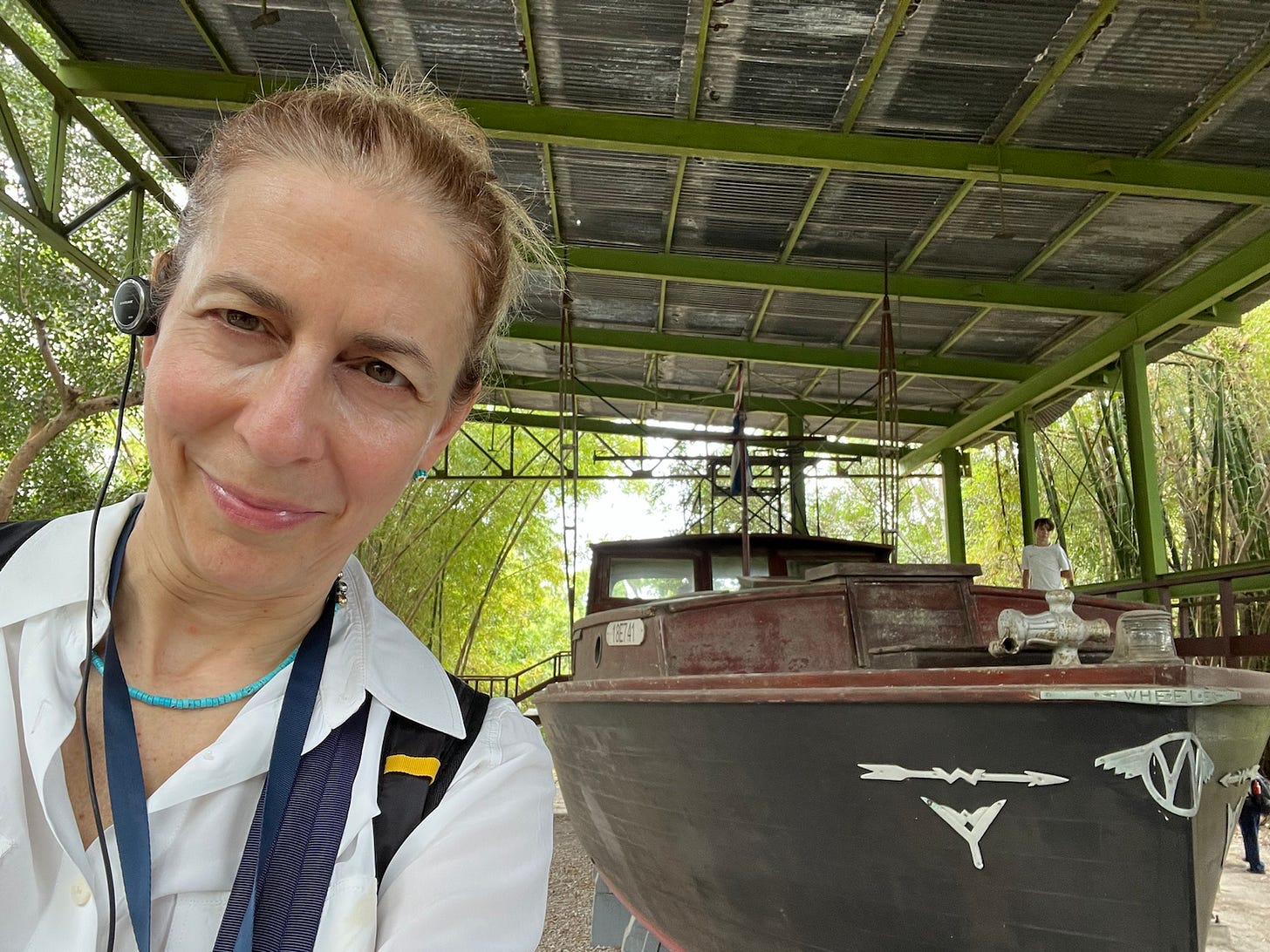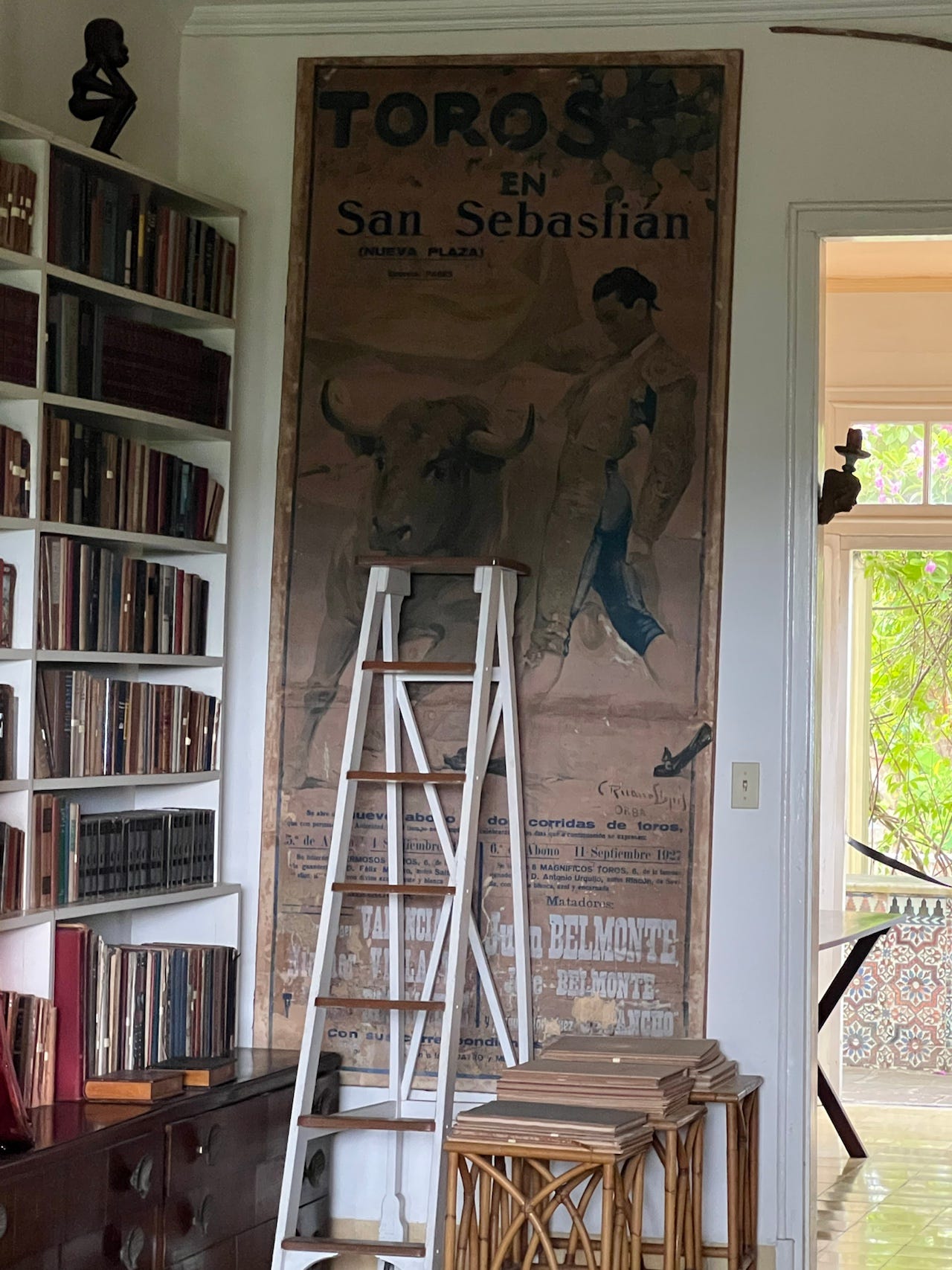Hemingway and Fish
Visiting Finca Vigía: Hemingway's Home in Cuba
Ernest Hemingway grew up fishing. He learned how to catch freshwater fish and trout in Walloon Lake in Michigan. Later in life, he famously caught marlin, tuna, and sailfish in Bimini, Key West, and Cuba. In 1956, he landed a 1000-pound, 14-foot marlin in Peru!
But he did far more than just catch fish. He studied fish and kept logs of what happened on his fishing expeditions. Readers got a chance to immerse themselves in Hemingway’s world of fishing with the publication of The Old Man and the Sea in 1952. Hemingway’s long and successful writing career led to him being given the Nobel Prize for Literature in 1954.
My closest experience with fishing was as a kid at the Pleasant Acres Farm RV Resort in Sussex, NJ, trying to catch sunfish for our family cat. I remember it so clearly, the small rod and bait dangling, but I would have a lot to learn about fishing. Even though I don't fish, I do appreciate fish. I like eating fish, and I know a lot of people do. Over the past few months, I have also been thinking about where my fish comes from.
For Ernest Hemingway, the answer was simple—straight out of the ocean, lakes, and rivers. By the time he left Cuba in 1960, wild fish was what people still caught and ate because fish farming was not yet popularized.
But over the decades, aquaculture emerged, along with dyes, antibiotics, preservatives, and processing additives entering the fish industry. Today, unlike in Hemingway’s time, we need to read labels carefully in the store and quickly look up anything we want to know more about on our phones.
Fishing: Hemingway’s Lifelong Passion
Hemingway was devoted to fishing and after he passed away his fishing boat, Pilar, became a shrine to it. Today it is permanently in a dry dock where there had once been a tennis court at his former home in Cuba, Finca Vigía. Having a chance to see his home, the famous Pilar as well as better grasp his writing environment were some of the motivations for my interest in seeing his home in Cuba.
Hemingway would take friends and family out on the Pilar. Sometimes, he'd even hand the rod to a friend, hoping they’d land a big one. Hemingway was fortunate to have close friendships with Cuban fishermen like Carlos Gutierrez and Gregorio Fuentes from whom he learned so much about fishing.
Lore has it that his boat captain, Gregorio Fuentes, inspired the character of Santiago in The Old Man and the Sea, but I couldn’t find anything that proved that or that Hemingway himself had said it. Santiago was likely a compilation of many Cuban fishermen that Hemingway knew.
Through Hemingway’s fishing experiences with fishermen and friends, meals were always part of the tradition. In a dissertation by Mark P. Ott, submitted to the University of Hawaii library, entitled A Sea Change: The Gulf Stream and the Transformation of Ernest Hemingway's Style: 1932 to 1952, I read what Hemingway had for lunch on the boat on July 30, 1934:
"Macaroni with meat, avocado (noted in the record as ‘avocado’) salad, ham, and fruit salad."
For Hemingway, fishing was beyond just the catch. It was about sharing food, stories, and camaraderie. Given Hemingway’s well-documented love for a good drink, alcohol was likely served during the meals on the Pilar.
Hemingway knew fish better than most. He studied them, knew the water, developed techniques, and pushed the sport forward. He kept logs of what he learned. He was a naturalist, reading marine science books and learning the tides. His expertise in big game fishing—marlin, tuna, sailfish, tarpon—was legendary. For him, fishing was a battle, and it had to be an honest fight between man and fish. Anything less didn't seem right to him. Both he and the fish deserved that fairness.
Hemingway’s understanding of fish enabled him to contribute his observations and specimens to the Academy of Natural Sciences. As a member and later vice president of the International Game Fish Association, Hemingway contributed his thoughts on fair game fishing practices and his concerns about overfishing and sustainable fishing techniques. He was ahead of his time.
Exploring Hemingway’s Home
Visiting Finca Vigía I naturally thought about more than just fish—I was curious about Hemingway’s literary career and how he lived here for two decades.
Visitors aren’t allowed inside the house, so you have to look through partially open doors and windows. This was less of a limitation than I had anticipated.
A line had gathered at the front of the house, everyone craning their necks to see inside. Instead, we were led around the back, where we could peer through the windows into Hemingway’s world.
A simple blue blanket covered the bed in the bedroom, with newspaper clippings on top. Bookcases lined two walls, filled with volumes Hemingway once read. A mounted head—perhaps an elk or deer—stood guard over his belongings. A Cuban woman watched the scene unfold, silent, distant, possibly wondering why these visitors were so obsessed with Hemingway’s possessions.
We could see the typewriter where Hemingway stood to write. It was a modest setup for a larger-than-life character.
Another room revealed Hemingway’s desk, more mounted trophies, and framed artwork, likely from famous friends. Books lined every wall. Hemingway was a voracious reader; every writer should know that reading teaches you writing.
More books filled the space in yet another room, waiting for Hemingway’s return. The house is frozen in time, memories of a life that had survived the First World War, passionate love affairs, and more than one divorce, as well as the thrill of African safaris and Spanish bullfights. A bullfighting poster caught my eye—of course, Hemingway was captivated by that world, too. (The Sun Also Rises, his novel on bullfighting, comes to mind.)
I looked around for the kitchen but couldn’t find it, assuming that part of the house wasn’t open to visitors. Later, when I got home, I found a photo on TripAdvisor showing a small, simple kitchen with plain white cabinets, a sink, an icebox, and a table. Functional—it seemed that Hemingway appreciated practicality, but he also lived well, as Finca Vigía looked like a very comfortable home, with floral couches and decorative objects against clean hardwood floors.
In the backyard, I climbed the tower steps to glimpse the foggy window of Hemingway’s supposed writing retreat—though he was more likely to write in his bedroom. The telescope inside made me wonder if Hemingway enjoyed stargazing, but of course, that’s just my speculation.
The empty swimming pool was once a refuge from the Cuban heat on another part of the grounds. Legend has it that actress Ava Gardner swam nude in this pool, adding to the mystique of Hemingway’s home.
Even now, the property felt large, though the surrounding neighborhood in San Francisco de Paula, near Havana, has become run-down. But when Hemingway’s third wife, the fearless war correspondent Martha Gellhorn, found Finca Vigía, it was a peaceful and beautiful 15-acre estate. It was a perfect place for a world-famous writer and his accomplished wife. Thanks to Martha, he bought it and made it his own.
The Hemingway Table: What Was on His Plate?
I had hoped there was information about the meals served at Finca Vigía, especially what the Hemingways liked to eat regarding fish. However, the guide had no information other than that a cook prepared the meals for the Hemingways and their guests who included Gary Cooper and Spencer Tracy.
Fish and the local foods had to be on the menu. A vegetable garden was marked on the museum’s map. It’s near the entrance to the property, though there was nothing I could see there now.
Food was served family-style at Finca Vigía, with guests gathering around a long table. That table remains empty today, but it’s easy to picture lively conversations, wine bottles passed around, and plates filled with fresh seafood—perhaps the fish Hemingway caught himself.
(The Hemingway Cookbook by Craig Boreth (2012) shares his favorite dishes, and you can check out pictures of Hemingway trout fishing as a young boy in the sample read on Amazon. His fourth wife, Mary, contributed to this book.)
A Lesson from Hemingway: Know Your Fish
Hemingway instinctively knew it was important to know something about the fish. We should, too. We don't have to be deep-sea anglers to ask someone at the counter if they know a little bit more about the fish or read the description on the package. By doing so, we can become more aware of the fish we serve and consume with our family. I'm betting that Hemingway would be pleased to see us take a professional interest in the seafood we have in our diet.







Love this post. The Sun Also Rises was my gateway drug to literature and all through my 20s, I was obsessed with the Lost Generation. I don't know a lot about his life in Cuba so this is wonderful revelation.